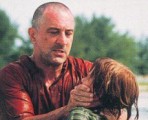|
With mediocre reviews stemming from unfair
comparisons the recent Great Expectations film has been unseen by many
film fans who tend to faithfully follow some the most conservative critics
views. These film journalists dare not praise the modern film because by doing so they may potentially risk
tarnishing the untouchable masterpiece of 46' - and thereby incurring the
wrath of cinema historians and film scholars.
In direct comparison though Cuarón's version seems to shine quite brightly against
the somewhat stilted production and performances of yesteryear. Dare I say -
it is a superior film in almost every sense.
Mitch Glazer's unique screenplay adaptation
of the Dickens novel is both creative and pays worthy
homage to the original story not deviating from its basic themes and
principles. 'Pip' from the book has become "Finn", a
shortened form of Finnegan. His patriarch's blue-collar occupation moves from a
blacksmith to a fisherman/handyman and the location from the English moors to the
gulf coast of Florida. His social status elevation is not simply an
educated gentleman but one of a successful
artist - and his benefactor is once again an escaped convict burying inside
him a deep code
of honor. In the 98' film it is played with
successful mystery, stealth and seething aggressive power by Robert De Niro,
whose screen presence is always consistently strong.
In this more modern adaptation the love interest of Estella is dealt in more
of a romantic vein. A lithe Gwyneth Paltrow adeptly enhances the role of the the ice
princess devoid of true emotional attachments. This performance literally glows against
the miscast portrayal by Valerie Hobson in Lean's film. Cuarón's masterful framed shots and vistas
meld gently with the softly plucked guitar strings in the soundtrack. The
floating camera helps create a poetic atmosphere as we witness the maturation of a young man.
More on the performances - a young Alec
Guinness (Herbert Pocket) in his first credited role is adept in Lean's
version with no corresponding character in Cuaróns, but the most extravagant
difference is in the Miss Havisham character from Dickens text. As a device
the character is the misconstrued benefactor and mentor to Estella's muted passions.
Anne Bancroft transforms this into the flamboyant and eccentric Ms. Nora Dinsmoor who lives in a dilapidated old southern mansion called
Paradiso
Perduto ('Satis House' in the original). It is covered with creeping vines and overgrown
foliage as her classroom for young Estella. Miss Havisham, played by Martita
Hunt in Lean's black and white expose is almost asleep in comparison. Ms.
Dinsmoor dances around with caked on makeup and a cigarette holder
exemplifying her wealthy-bag-lady expression. Bancroft is wonderful and
borders on stealing each scene that Ms. Dinsmoor appears.
We can now ask - Is the
original story perhaps out of touch with a modern audience?
Certainly the attempt at updating should not be met with the huge indifference. The
basic plotline of the story is read by almost every high school student and
has become a well-worn classic, if only from the stance of its prolific
nature. Could the youths of today
relate more closely to Cuarón's contemporary narrative? I would suspect the
answer is quite positively 'yes'. Some of the obvious interrelated
differences are social values, pre-marital sex and single parenthood which
are all unusually common today in western culture. Expecting youths of today
to fully appreciate the courting rituals of such a distant past is
unrealistic.
Cuarón does more than just adeptly update
the story - he floats his camera around the film like director Anh Hung Tran
in "The Scent of Green Papaya". Observant fans will notice the great
difficulty and preparation and how he tackles the painstaking choreography.
His story is told with the grace of a ballerina and the occasional
interjecting of narration by "Finn" as we are seeing the story through his
eyes. It is a shame that the work ethic, diligence and creativity of this
film are so unrewarded and unnoticed.
To quote Robin Wood (from his Cineaction
magazine - issue 55) with an excerpt from his article on Ethan Hawke:
"Anyone wanting a precise comparison with Lean
might look at the two treatments of the pivotal scene in which Joe visits
the newly affluent Pip in the city, to Pip's embarrassment and Joe's
humiliation. In Lean the sequence is staged and shot with no more
distinction that an average TV sitcom; in Cuaron it becomes a masterfully
orchestrated piece of pure cinema, perfectly judged in tone, superbly
choreographed. Lean is 'faithful' to Dickens text, Cuaron's is intelligently
rethought in contemporary terms, and extensively developed..."
I agree with Robin
completely, and this certainly does not diminish the original nor the
admiration and respect I have for David Lean. Cuaron's filmmaking was well
thought out and yet still acknowledging the original... standing on Lean's
shoulders if you will... producing a more in-depth and focused view of the
same incident.
Roger Ebert
states in his review:
"...Great Expectations'' doesn't finish at the
same high level that it begins (if it did, it would be one of the year's
best films)..."
Perhaps we have come to a more definitive
criticism of this hidden gem of a film. Not that I agree. Personally I
didn't find any failing of the ending at all, but suspect that its
divergence from the Lean version is sadly unacceptable to some, especially
those trying to seek fault at any level. With the chance meeting of Finn and
Estella (and her daughter who we suspect comes from a broken marriage) it
seems once again to put a more modern branch on the story... and as with the
original, your imagination is left to conclude their fate. To me this is the
perfect formulation of an ending. It is less judgmental or cloying and often
about as realistic as life can get. To contain something definitive would
have been too expected and typical of "Hollywood" in my mind.
Cuarón's film is filled with rich
beautiful images, modern circumstance, rewarding performances and a gentle
and profound musical score. Taking the unpopular stance is not uncommon for
this reviewer and I find it an infinitely better and more enjoyable film
than Lean's stayed original which strengths I found mostly in the
time-honored story of Dickens not in its adaptation to the screen.
|
![]()
![]()

![]()
![]()



























